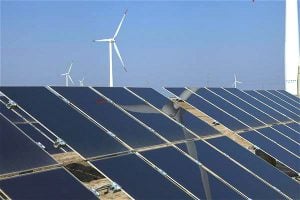It has been called the paradox of the German energy transition. Although Germany is on track to generate a third of its electricity from renewables this year – the highest share among major industrialised countries – it continues to lead the world in the amount of energy produced from the most-CO2 intensive fossil fuel: lignite coal.
Rather than being pushed out of the market by its clean competitors, coal-fired power generation has held steady in Germany. Together hard coal and lignite generate more than 40% of Germany’s electricity, and the share of lignite has stubbornly remained at around 25% of gross power generation. Its share of Germany’s primary energy mix currently stands at 12%.
According to German environmentalists, the resilience of coal is a result of the lack of a consistent energy policy – including a clear approach to coal.
The Merkel government has now taken a first step towards the goal of a permanent coal phase-out by 2050. It recently reached a deal with energy utilities to gradually shut down the country’s most polluting lignite plants by 2020. The decision to take 2.7 GW of coal-fired power, some 13% of current lignite capacity, off the grid between 2016 and 2019. This will result in emissions reductions of 12 million tonnes, more than half of the 22 million tonne gap Germany will need to close if it is to meet its 2020 goal of reducing carbon emissions 40% below 1990 levels.
“Everyone in Germany knows that this is only a first step towards decarbonising the power sector,” says Patrick Graichen, director of the energy policy think-tank Agora Energiewende in Berlin.
Even though the German "coal renaissance" of 2012 and 2013, when coal-fired power generation increased substantially, turned out to be short-lived, Germany’s addiction to coal remains difficult to break.
Germany is the world’s biggest producer of lignite, and with 40 billion tonnes, it is has some of the world’s largest reserves. The country’s lignite-fueled power plants emit some 170 million tonnes of CO2 per year, almost half of the total CO2 emissions from the German power sector.
The brown coal is cheap to mine and has to be burnt locally because its high moisture content and low energy density make it inefficient to transport or trade. Comparatively expensive hard coal-fired plants have also held up relatively well due to the slumping price of coal on world markets, the result of slowing consumption in China and the US shale oil boom.
According to German environmentalists, the resilience of coal has more to do with mistakes in energy policymaking than with the decision in 2011 to phase out nuclear energy after the disaster in Fukushima in Japan (the new coal plants brought online post-Fukushima were commissioned long before the accident).
Domestically, some policymakers now regret decisions taken during the energy transition’s early days. Under the European Emissions Trading System (EU ETS), utility companies were given strong incentives to decommission old power plants and replace them with more efficient ones. But in the initial years of its implementation in Germany there were no incentives to switch fuel sources, explains Arne Jungjohann, an independent energy analyst based in Stuttgart.
According to Jungjohann, these incentives, and not the nuclear phase-out that was reinstated by the Merkel government after the nuclear disaster in Fukushima in 2011, prompted the “coal renaissance” in 2012.
In their report “The German Coal Conundrum” he and his co-author Craig Morris point out that, rather than filling a gap left by nuclear, additional lignite capacity came online at a time when Germany – thanks to the boom in renewables – started producing more energy than it needed, exporting record amounts to neighbouring countries.
The German government should have focused on strengthening the position of gas plants in the power sector rather than throwing coal a lifeline, says Jungjohann. Natural gas is the fossil fuel that is most compatible with renewable energy. Gas plants are less carbon intensive than coal plants and their relative flexibility makes them the fuel of choice to compensate the irregular production cycles of the weather-dependent renewables.
When the European cap-and-trade system started in 2005, policymakers also hoped that putting a price on carbon would increase gas-fired generation's cost-effectiveness relative to coal-fired generation. Looking back, most experts agree that the cap was not set at a level ambitious enough to reach this goal. The global economic crisis of 2008 led to lower economic output and lower emissions, causing the carbon price to drop to record lows – with the effect that gas rather than coal plants were being pushed out of the market. Between 2010 and 2014, gas’s share of Germany’s power mix declined from more than 14% to under 10% of Germany’s power mix.
All agree that it is extremely hard to fix this market. “In order to substitute coal with gas, we would need an emissions trading price of a minimum of 40 euros per tonne of CO2,” estimates Claudia Kemfert, head of energy research at the German Institute for Economic Research in Berlin. “But the price right now is 7 euros per ton of CO2.” Despite recent steps to reduce the oversupply of emissions certificates on the EU ETS market, Kemfert does not believe the price of CO2 will rise high enough to phase out coal.
Instead, a political decision was needed to herald the end of coal-fired power generation in Germany. And just as during the introduction of the European cap-and-trade system, the German government had to compromise to reach an agreement with the industry and its unions.
Deal
The initial plan was to impose a tax on the plants that would likely have led to their shutdown. But, bowing to pressure from mining unions and their local allies, the Merkel government sweetened the deal. Under the recently revised policy, power companies RWE, Vattenfall and Mibrag will be paid not to produce power during a transition phase – with the exception of the unlikely event of emergency conditions in which energy demand would exceed supply. For German consumers, this means they will have to pay €0.05 more per kilowatt hour to fund reimbursements to the providers of around €230 million per year, adding up to €1.6 billion over seven years.
The decision has been criticised as an unnecessary farewell gift to the power companies, with some critics even asking if the reimbursements would violate EU guidelines on unnecessary government subsidies. “We already have a capacity reserve for winter times which is big enough to provide energy security at all times,” Kemfert notes. Also, as energy analyst Jungjohann remarks, coal plants are not suited to a reserve role since heating them up takes too long to overcome a short-term supply bottleneck.
Nevertheless, Graichen, a former environmental policy-maker in the German government, calls the compromise a major accomplishment. “This was the first time ever that utilities, unions and the government agreed on shutting down power plants as part of climate policy,” he says. While he acknowledges that the 21,000 jobs in the lignite industry are a tiny part of Germany’s workforce, he notes that the industry remains a key economic contributor to some regions, and that “it will be important to offer those employees new perspectives and job opportunities.”
Divestment
Meanwhile, lignite miners and power plant operators in East Germany’s economically-depressed Lausitz region might get yet another reprieve. In order to divest itself of lignite, Swedish utility company plans to sell all of its facilities in the region. According to news reports, two Czech consortiums are in the running to acquire the assets. The environmental campaign group Greenpeace had also previously expressed its interest to purchase the mines and plants with the intent to shut them down, but has been informed by Citigroup, the bank that handles the transaction, that it has been excluded from the bidding process.
Graichen refuses to speculate about any serious potential buyers’ motivation, but he makes it clear that the proposed deal sounds like a bad idea to him: “To my mind, investing in high carbon assets is not only morally wrong but also financially very risky since it would be a bet against future decarbonisation policies.”
He and others in the German environmental community continue to express confidence that the country’s recent coal renaissance, rather than being a turnaround in the industry’s fortunes, has more than likely been its last hoorah.







